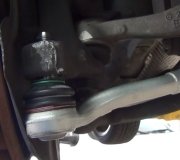It is easier to see on the car, but you have to jack up at least one wheel so you can spin it. I run the car, in gear, on a hoist, but one wheel will always want to spin and the other one comes to a stop. That is normal. If you jack the car up so one tire is still on the ground, the other one will spin. If you jack it up so both tires are off the ground, inspect the tire that spins, then apply the brakes to stop it, shift to neutral if necessary, then put a block of wood under that tire. That will force the other tire to spin when you put it in "drive" again.
The easiest broken belt to spot looks like a tumor, or hump, on one side of the tread, and in just one part of the tire. Those are easy to see as the tire spins, but not always easy to see when just looking at a stationary tire. When a belt is really badly broken, the entire tread will squirm left and right as it rotates. Those are the ones that can make you seasick just driving slowly down the road.
The hardest broken belts to find are usually overlooked by most untrained mechanics. The belt comes apart so slowly that as the hump in the tread forms, it wears down from normal driving. That makes the tread appear to be perfectly fine. What you have to look for is the tread at the bottom of the grooves. One or two of those grooves might be rising and falling as the tire rotates, but the part of the tread that contacts the road surface looks okay.
The best place to go for this is a tire and alignment specialty shop. I learned how to spot those more elusive broken belts from a service adviser/salesman at a mass merchandiser, in the mid 1980's. I was taking old tires home to use on my cars, and they would always develop the vibrations after a few weeks. I could see the broken belts then, but it stumped me how he knew they were causing problems when they looked fine otherwise. He was looking at the grooves in the tread, not just the tread surface. That is what the specialists at the tire and alignment shops look for too.
Thursday, June 8th, 2017 AT 4:55 PM


